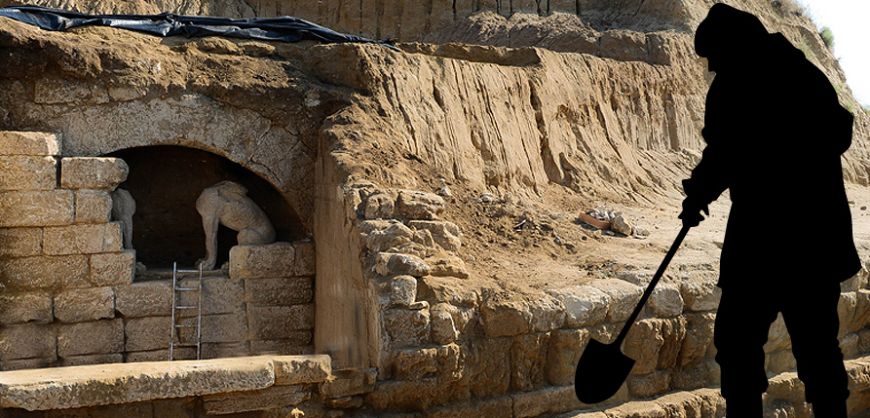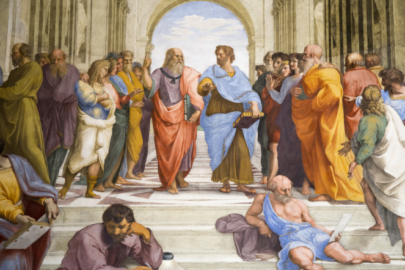Guesstimates continue to point to an extremely prominent ancient celebrity buried at the tomb of Amphipolis, especially bearing in mind that two sealing walls were used prior to the tomb being filled to the roof with sand. Another school of thought, however, suggests that the sand filling the tomb may not have been created to keep out the tomb robbers but by those who had previously pillaged the ancient tomb themselves. There may have been particular resentment against the occupant of the tomb and the world which that occupant had possibly ruled over.
The third chamber tells a particularly sad tale with a shocking revelation. The trench in the area indicates that a shrine which is now missing may have been placed there. The pit’s dimensions are 4 x 2.1 meters. Archaeologists can only but speculate as to the purpose of the basin in the ground.
The second leaf of the Ionic door, a piece of marble weighing 1.5 tons was away from its matching leaf, buried deeper in the soil that sealed the tomb. Photographs issued by the Ministry of Culture shows another view of the door, frugal, shattered and poor in terms of decor. The striking difference between the two sides lead one to believe that they belong to two different doors. A missing part of the door could indicate vandalism, a view that would serve to explain the absence of findings now that the excavation has reached the third chamber and is 1.4 meter deeper from the previous chamber. Still, the Amphipolis monument is full of surprises even when it reveals a suspicious and ominously empty tomb.
The excavation is continuing and anything goes. The scenario that has gained ground in recent days is that the tomb had been looted for a specific purpose – to wipe it out from the face of the earth and ensure its disappearance along with any memory of the occupant within.
The triple seal – two vertical and one horizontal – along with the tons of soil that were transfered to the tomb from the Strymon River show that the entry to the tomb was not merely a case of ordinary grave robbers but plunderers who had systematically stripped the tomb as part of a plan, possibly members of a service.
They worked in the light of day, without having to rush or loot as quickly as they could. Most archaeologists believe that the looting took place during the Roman era with campaigns to conquer Greek land, however it could also have occured during the Byzantine reign of Emperor Theodosios in the 4th century by fanatic Christians though this view is discounted as in such cases there were usually crosses erected in the place of ancient monuments.
On her part, U.S. Archaeologist Dorothy King told Proto Thema that the additional soil wasn’t put in the tomb by those destroying it but by those who tried to save it. She believes that only very important monuments fell victim to Christian iconoclasts and in this case the Casta Hill was used as a temple that honored Alexander the Great. She believes that the use of soil instead of cement could have been to salvage the tomb rather than destroy it. She adds that most of the damage came from above rather than within the tomb. She says that the soil in the tomb may have been created to keep it standing as the wooden columns had failed to hold it up. The doors broke, however the major damage came from pressure rather than attacks. The fact that parts of the Sphinx and wings were found in the tomb could also be evidence that they had been moved there in an effort to save them.
Ms. King offers another scenario as she speculates that the tomb may have been sealed when it was clear that Alexander the Great’s corpse would not be returning from Egypt. The damage may have been created by someone obsessed by the warrior king, such as Roman Emperor Caracalla who was obsessed by Alexander the Great to the point of having delusions. The specific emperor only wanted one tomb for Alexander the Great.
Ms. King doesn’t disagree that the tomb has been plundered. She believes that the third chamber seems empty because tapestry or works of art were detached or destroyed.
Geologist Stavros Papamarinopoulos, a member of the Association of Greek Archaeologists, believes that a monument such as that of Amphipolis cannot possibly end at the third wall of the third chamber. He says that Yiannis Sakellarakis had made an important discovery on the isle of Crete after encountering an empty tomb and realizing that one floor area was different to the rest only to open an area of underground treasures. Geological studies have already shown that there was more than one entrance to the site and Mr. Papamarinopoulos believes that there may be a tunnel that connects the two sides of the tomb.



































